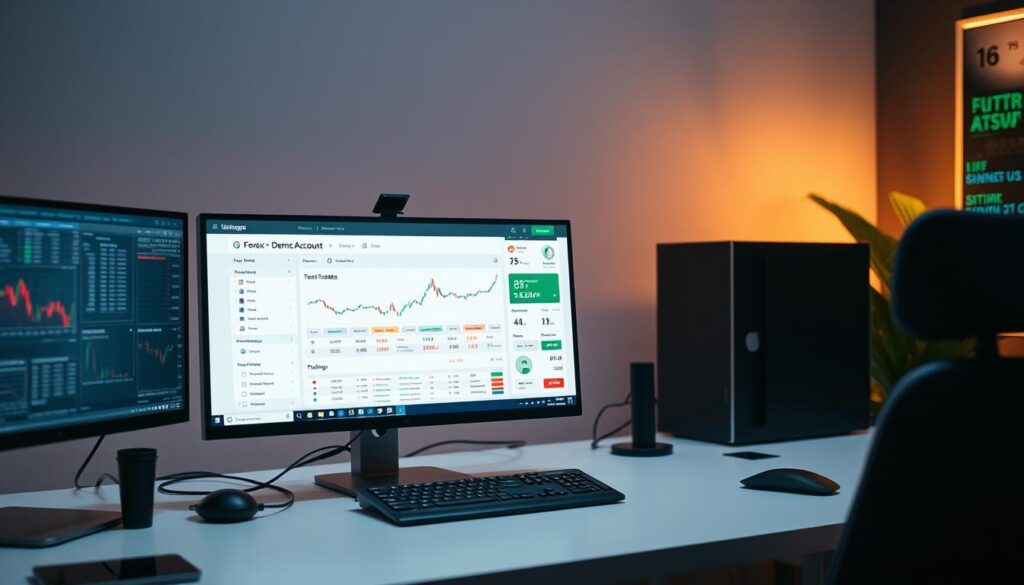Entering the world of currency exchange is a significant step. The potential for profit exists, but the risks are very real. Data shows that a majority of retail accounts lose money when trading Contracts for Difference (CFDs).
For those new to the market, choosing the right platform is the most critical first decision. A good partner can provide a solid foundation for learning and growth. A poor choice, however, can lead to unnecessary losses and frustration.
This guide is designed to cut through the noise. It helps newcomers identify the hallmarks of trustworthy firms. It also highlights the warning signs that all smart traders should avoid.
Readers will learn to evaluate key features like regulatory standing and fee transparency. The goal is to provide the knowledge needed to start this journey with confidence and caution.
Understanding the Forex Market for Beginners
Navigating the global currency exchange requires a solid grasp of its core mechanics. This market is the largest financial marketplace in the world. Trillions of dollars change hands every single day.
An Overview of Currency Trading
Currency trading involves the simultaneous buying of one currency and selling of another. Common pairs include EUR/USD and GBP/USD. This activity takes place 24 hours a day across major global financial centers.
The high liquidity offers significant opportunities. However, it also presents considerable challenges. Success demands discipline and a deep understanding of what moves prices.
Recognizing Risks and Rewards
The potential for profit from currency fluctuations is a major draw. The market’s accessibility is another key advantage. Yet, this is balanced by inherent dangers.
Leverage can amplify losses rapidly. Market volatility and complexity are constant factors. Most retail traders lose money due to inadequate preparation.
Understanding economic indicators and geopolitical events is crucial. Realistic expectations and a solid education form the foundation for navigating these complex markets safely.
The Importance of Choosing the Right Broker

A trader’s initial platform selection establishes the framework for their entire learning journey and potential success. This decision impacts everything from security to educational support.
Regulatory oversight provides the first layer of protection. Reputable authorities like the FCA and ASIC ensure firms follow strict financial standards. This safeguards client funds through segregation and compensation schemes.
The right partner offers features specifically designed for market newcomers. These include demo accounts for practice and user-friendly platforms. Comprehensive educational resources help develop essential skills.
Poor choices can lead to significant problems. Hidden fees may erode profits while inadequate support leaves questions unanswered. In extreme cases, unregulated entities might risk deposited funds.
This makes systematic evaluation crucial before opening live accounts. Understanding key criteria helps traders avoid marketing hype. The following sections detail specific green and red flags to consider.
Spotting the 3 Red Flags in Forex Broker Offers

Identifying warning signs before committing funds is a crucial skill for any new market participant. Certain practices can significantly increase the high risk already inherent in this activity. Statistics show that a majority of retail investor accounts lose money when trading CFDs.
This makes careful selection vital to avoid platforms that contribute to this outcome.
Hidden Fees and High Leverage Risks
The first major concern involves costs and leverage. Hidden fees, like withdrawal or inactivity charges, quietly reduce capital. This makes it harder to profit and increases the chance you will lose money.
Excessive leverage is another critical danger. While regulated offers are capped, some platforms provide much higher ratios. This can cause an account to risk losing money rapidly from small market moves.
Poor Customer Support and Transparency
The second red flag is inadequate support and unclear policies. Slow responses or unhelpful staff leave traders without guidance. A lack of transparency about fees or order execution is equally troubling.
Legitimate services clearly explain their operations and risks. They acknowledge that CFDs are complex and carry a high risk of losing money. Be wary of any entity that downplays these realities or promises guaranteed profits.
Why “Forex Brokers for Beginners” is a Critical Term

This specific search term represents a crucial distinction in the trading landscape. It signals services designed for those taking their first steps in currency markets. The phrase reflects unique needs that differ greatly from experienced participants.
Newcomers require fundamentally different platform features. They need educational support over advanced tools. Simple interfaces reduce learning curves better than complex software.
Services targeting this group prioritize client education above aggressive marketing. They offer structured learning paths and risk-free demo accounts. Support teams are trained to answer basic questions patiently.
The critical nature becomes clear when considering market statistics. Inappropriate platforms can lead to higher failure rates. This happens through inadequate preparation and excessive leverage.
The best providers balance accessibility with protection. They implement safeguards like negative balance protection. Understanding this terminology helps filter hundreds of options effectively.
It identifies firms committed to newcomer success rather than simply acquiring depositors. This distinction ultimately supports more sustainable entry into currency trading.
Evaluating Broker Offers and Trading Platforms

A thorough evaluation of a broker’s trading platform is a non-negotiable step for any newcomer. This process goes beyond flashy advertisements to test the actual tools and environment where trading will occur.
Demo Accounts and Virtual Trading
The most valuable tool for this evaluation is a demo account. It provides a risk-free environment to practice with virtual funds. This allows users to become comfortable with the platform’s features without financial pressure.
These accounts simulate real market conditions. Traders can test strategies and experience volatility. The goal is to build confidence before transitioning to a live account.
Ease of Use Across Platforms
Ease of use is a critical factor for a positive experience. The best trading platforms prioritize an intuitive interface. Complex systems can overwhelm those just starting out.
It is essential to test the platform on different devices. Consistency between web, desktop, and mobile apps is key. A seamless experience ensures you can manage your account from anywhere.
Platforms like IG and eToro are known for their user-friendly designs. They offer clear navigation and integrated learning tools. This support helps newcomers focus on learning rather than struggling with software.
How Broker Educational Content Impacts Trading Success

Comprehensive learning resources available through market platforms serve as the foundation for building sustainable trading skills. Quality educational resources significantly shorten the learning curve for newcomers. They help participants avoid common mistakes that often lead to losses.
These materials support traders throughout their entire journey. Beginners learn fundamental concepts while experienced participants refine advanced strategies. This progressive approach ensures proper skill development.
Webinars, Tutorials, and In-Depth Guides
Interactive webinars provide real-time learning opportunities. Participants can ask questions and watch live market analysis. This interactive format helps bridge theory and practical application.
Video tutorials offer step-by-step guidance on platform navigation and strategy implementation. Visual demonstrations make complex concepts more accessible. Many find this format easier to understand than written instructions.
In-depth articles and guides allow for self-paced study. Traders can revisit difficult topics until they achieve mastery. This flexibility supports different learning styles and schedules.
Platforms like IG and eToro organize their educational resources by experience level. This structured approach guides users from basic to advanced topics. Such organization enhances the overall trading experience for all participants.
Understanding Trading Platform Features and Tools

Modern trading platforms provide a suite of tools that empower market analysis and capital protection. These features transform raw price data into actionable insights. The right combination of charting and risk management tools can significantly improve decision-making.
New participants should focus on platforms that balance power with accessibility. Intuitive interfaces help avoid the overwhelm that complex systems can create.
Advanced Charting and Risk Management Tools
Charting capabilities form the foundation of technical analysis. Platforms like MetaTrader 4 and TradingView offer multiple timeframe views. They include drawing tools for trend lines and support levels.
Technical indicators help identify patterns and momentum. Common tools include moving averages, RSI, and Bollinger Bands. These analytical instruments support informed entry and exit decisions.
Risk management features are equally critical for sustainable participation. Stop-loss orders automatically limit potential losses at predetermined levels. Take-profit orders secure gains when price targets are reached.
Some platforms offer guaranteed stop-loss orders that eliminate slippage risk. This protection is particularly valuable during high volatility. Understanding these tools helps newcomers develop disciplined approaches from their first trades.
Assessing Minimum Deposits, Spreads, and Commissions
Cost assessment forms the foundation for sustainable market participation. Understanding entry barriers and ongoing expenses helps traders make informed choices. This analysis prevents unexpected costs from eroding potential gains.
Comparing Costs Across Brokers
Fee structures vary significantly between different platforms. Some firms like OANDA and XTB feature $0 minimum deposit requirements. Others such as IG maintain a £250 threshold.
Spread differences create substantial cost variations. Pepperstone’s Razor account offers spreads from 0.10 pips with commissions. Their Standard account provides commission-free trading with wider spreads starting at 1.10 pips.
Traders should calculate total expenses including overnight financing and withdrawal fees. The best forex brokers maintain transparency across all charge types. This clarity helps participants budget accurately.
Value of Low Minimum Deposit Options
Reduced entry barriers benefit those starting with limited capital. Lower minimum deposit requirements allow testing platforms with smaller commitments. This approach minimizes risk during the learning phase.
Platforms like CMC Markets and Interactive Brokers enable opening accounts with any amount. This flexibility supports gradual scaling as skills develop. It represents a significant advantage for cautious newcomers.
Wire transfer fees and currency conversion costs should factor into deposit decisions. Smart money management begins with understanding all financial requirements. This comprehensive view supports long-term success.
The Role of Risk Management Features in Broker Platforms
Modern trading platforms integrate sophisticated tools specifically designed to mitigate financial exposure. These features help participants manage the high risk inherent in market participation. Proper use prevents accounts from losing excessive capital during volatile conditions.
Stop-loss orders represent the fundamental protection mechanism available to traders. They automatically close positions when prices reach predetermined levels. This limits potential losses to acceptable amounts based on individual risk tolerance.
Stop-Loss and Guaranteed Stop-Loss Orders
Guaranteed stop-loss orders (GSLO) provide enhanced security against slippage. Services like Plus500 ensure positions close at exact specified prices regardless of market volatility. Traders pay a premium fee for this absolute protection against unexpected gaps.
Advanced platforms offer additional risk management tools including trailing stops. These dynamically adjust stop levels as prices move favorably. They lock in profits while maintaining downside protection during market reversals.
Leverage control represents another critical safety feature. Platforms such as Pepperstone allow manual adjustment below maximum available levels. Choosing 5:1 instead of 30:1 significantly reduces exposure and potential for rapid capital depletion.
UK regulatory frameworks provide additional security layers for retail participants. These include 30:1 leverage caps on major pairs and negative balance protection. Segregated client funds and mandatory close-out margins further safeguard against extreme losses.
Effective risk management combines multiple tools with disciplined position sizing. Using stop-loss orders on every trade, realistic leverage, and diversification creates safer trading environments. These practices help newcomers develop skills while controlling financial exposure.
The Impact of Copy Trading for New Forex Traders
Automated strategy replication through social networks offers a practical bridge between theoretical knowledge and real-world application. This approach allows market participants to observe professional decision-making in real time.
Platforms like eToro pioneered this concept with their CopyTrader feature. Users can mirror trades from verified Popular Investors with proven track records. This creates a hands-on learning environment.
Benefits of Social Trading Platforms
The copy trading approach provides immediate access to experienced strategies. Beginners can potentially generate returns while developing their skills. They observe risk management techniques and position sizing in action.
Social platforms offer sophisticated filtering tools. Users can find strategies matching their risk tolerance and market preferences. eToro’s CopyPortfolios extend this concept with diversified options.
Other services like Pepperstone’s DupliTrade and Fusion Markets’ Fusion+ provide similar functionality. ZuluTrade and cTrader Copy offer additional alternatives for strategy mirroring.
While copy trading doesn’t eliminate risk, it serves as valuable education. Past performance doesn’t guarantee future results. Proper due diligence remains essential throughout the learning process.
Regulatory Protection and Investor Security in the UK
Investor security begins with selecting a platform that operates under the oversight of a reputable authority. In the United Kingdom, the Financial Conduct Authority (FCA) sets the standard for protecting retail clients.
The FCA mandates several crucial safeguards for firms offering financial services. Client funds must be held in segregated accounts, separate from the company’s operational money. This prevents a broker‘s financial troubles from directly impacting trader capital.
FCA and Other Tier-1 Regulatory Bodies
For individuals just starting out, these protections are vital. The FCA requires negative balance protection, ensuring accounts cannot lose money beyond the initial deposit. Leverage is also capped at 30:1 for major pairs, a key measure to control risk.
Perhaps the most significant safety net is the Financial Services Compensation Scheme (FSCS). It covers deposits up to £85,000 per person if a regulated firm becomes insolvent.
Other respected global regulators include:
- ASIC in Australia
- CySEC in Cyprus
- BaFin in Germany
Top-tier platforms often hold multiple licenses. This multi-jurisdictional oversight adds layers of credibility and security. It is a strong indicator of a firm’s commitment to fair and transparent trading practices.
Understanding that CFDs are complex instruments with a high risk of loss makes this regulatory framework essential. It helps beginners avoid scams and entities that might operate without proper oversight.
Tools and Resources for Building Trading Experience
Practice platforms with virtual capital provide newcomers with essential hands-on learning opportunities. These resources help develop skills without financial pressure.
Utilizing Demo Accounts and Virtual Funds
A demo account creates a safe environment for learning. Most platforms offer $50,000 to $100,000 in virtual funds. Some services like Fusion Markets provide up to $999,999 for practice.
These simulated environments replicate real market conditions. Users can test strategies and platform features. Setup typically takes less than thirty seconds.
Key benefits of using demo tools include:
- Risk-free platform navigation practice
- Strategy testing without capital exposure
- Understanding how leverage affects positions
- Familiarization with different order types
Demo trading serves multiple purposes throughout development. Complete beginners learn basic functionality. Intermediate users test new approaches. Experienced participants evaluate different platforms.
While demo accounts lack real-money psychology, they build essential experience. Transition to live trading should occur gradually with small position sizes.
Effective use of these practice tools accelerates the learning curve. They help establish proper risk management habits before significant capital is at stake.
The Importance of Reviews and Broker Comparisons
Thorough research is a vital step before opening any new account. It helps people find the best forex services that match their specific goals.
Objective analysis from multiple sources provides a clearer picture than any single advertisement.
Using Expert Review Tools and User Feedback
Expert review sites conduct comprehensive testing. They evaluate dozens of criteria to identify the best brokers each year.
These reviews cover regulation, costs, and platform quality. The 2025 Annual Awards recognized top performers like IG and Plus500.
User feedback on sites like Trustpilot offers real-world perspectives. Traders share experiences about customer service and platform performance.
FP Markets, Fusion Markets, and AvaTrade have high ratings from thousands of users. This consistency across many reviews is a strong positive sign.
Comparison tools allow side-by-side evaluation of different platforms. This helps traders assess minimum deposits, spreads, and educational resources.
Looking for patterns in feedback is more useful than focusing on single complaints. Comprehensive research leads to smarter decisions.
This process helps identify the best forex platforms for individual needs. It is a critical step for successful trading.
Strategies to Avoid Losing Money When Trading
Market data consistently demonstrates that unprepared traders frequently encounter financial setbacks. Between 51% and 89% of retail investor accounts lose money when trading CFDs. This statistical reality highlights the need for disciplined approaches.
Successful participants treat currency markets as a business rather than gambling. They implement systematic processes with controlled risk parameters.
Developing a Robust Trading Plan
A comprehensive trading plan forms the foundation for sustainable participation. It should define clear entry criteria and position sizing rules. Most professionals risk only 1-2% of their account balance per trade.
Effective strategies focus on favorable risk-reward ratios. This means keeping average losses smaller than average profits. Even with a 50% win rate, traders can remain profitable through proper money management.
Position sizing represents a critical element often overlooked by newcomers. Calculations should consider account balance and stop-loss distance. This prevents traders from risk losing money beyond their budget.
Diversification across currency pairs and consistent stop-loss usage are essential. Beginners should focus on percentage returns rather than absolute amounts. Starting small allows for skill development without excessive exposure.
While practice and skill are required, success ultimately depends on discipline. Adherence to systematic plans proves more valuable than perfect market timing. This approach helps avoid the common pitfalls that cause accounts to lose money.
Final Thoughts for New Traders
Beginning a market journey requires careful preparation and a structured approach. Success hinges on education, discipline, and choosing the right partner.
Before committing real funds, study free educational materials. Practice with a demo account to gain experience without risk. Develop a clear trading plan and maintain a detailed journal.
Start with small position sizes and focus on managing percentage returns. Scale up only after establishing a consistent track record. Realistic expectations are crucial for long-term development.
While the path involves challenges, a methodical approach builds a solid foundation. Continuous learning and disciplined risk management are the keys to navigating the markets effectively.


